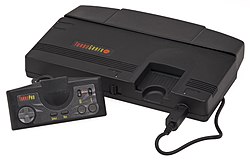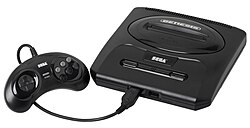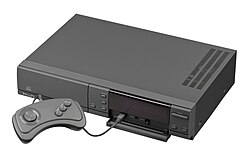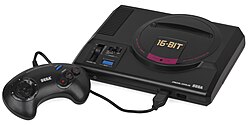History of video game consoles (fourth generation)
| Part of a series on: |
| History of video games |
|---|
The fourth generation of video game consoles began on October 30, 1987. The fourth generation (also called the 16-bit generation) began with the release of Nippon Electric Company's (NEC) PC Engine. Although NEC released the first fourth-generation console, this generation was dominated by Nintendo and Sega. Nintendo became the largest worldwide market share in the fourth generation. Sega was also successful in this generation. It began a new franchise, Sonic the Hedgehog. This was done so Sega could compete with Nintendo's Mario series of games. Many other companies released consoles in this generation. However, none of them were successful, except for Neo Geo from SNK.
The first handheld game console released in the fourth generation was the Game Boy, on April 21, 1989. The Game Boy became the most popular handheld game console. The Game Boy's screen had no color. However, many of its leading competitors did. Three major franchises were introduced for the Game Boy. These include: Tetris, Pokemon and Kirby. Many of the popular games in this generation originally started in the 8-bit generations. These titles include Mario, Metroid, Zelda, Star Fox, Kirby, Dragon Quest, Final Fantasy, Seiken Densetsu (Secret of Mana), Sonic the Hedgehog, Donkey Kong, Street Fighter, Mortal Kombat and Mega Man X.
The next generation would be the one that changed everything.
Home video game consoles
Comparison
| Name | PC-Engine/TurboGrafx-16 | Mega Drive/Genesis | Super Famicom/Super Nintendo Entertainment System | Neo Geo AES |
|---|---|---|---|---|
| Manufacturer | NEC/Hudson Soft | Sega | Nintendo | SNK |
| Console |  
|

|
 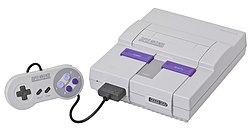
|

|
| Launch prices (USD) | US$199.99 | US$189.99 | US$199.99 | US$649.99 (Gold version)
US$399.99 (Silver version) |
| Release date | JP October 30, 1987NA September 1, 1989 EU 1990 | JP October 29, 1988NA September 15, 1989 EU November 30, 1990 | JP November 21, 1990NA August 23, 1991 EU April 11, 1992 | JP July 1, 1991NA 1991 |
| Media | HuCard (card-shaped cartridge) CD-ROM (Turbo CD add-on) |
Cartridge CD-ROM (Mega-CD add-on) |
Cartridge Magnetic disc (Japan only)[1] |
Cartridge Data card (Europe/Japan)[1] |
| Best-selling games | Bonk's Adventure[2] | Sonic the Hedgehog (15 million)[3] | Super Mario World, 20 million (as of June 25, 2007)[4] | Samurai Shodown |
| Backward compatibility | No | Sega Master System (using Power Base Converter) | Game Boy (using Super Game Boy) | No |
| Accessories (retail) | ||||
| CPU | HuC6280A (modified 65SC02) 1.79 or 7.16 MHz |
Motorola 68000 7.67 MHz (7.61 MHz PAL) Zilog Z80 3.58 MHz |
Nintendo-custom 5A22 (based on 65C816) 3.58 MHz (3.55 MHz PAL) |
Motorola 68000 12 MHz Zilog Z80 4 MHz |
| Memory | 8 KiB work RAM 64 KiB video RAM |
64 KiB main RAM 64 KiB video RAM 8 KiB audio RAM |
128 KiB main RAM 64 KiB video RAM 64 KiB audio RAM |
64 KiB main RAM 74 KiB video RAM 2 KiB audio RAM |
Other
Watara Supervision
Released in 1992Mega Duck/Cougar Boy
Released in 1993
Worldwide sales
| Console | Units sold |
|---|---|
| Super Famicom/Super Nintendo Entertainment System | 49.10 million [6] |
| Sega Mega Drive/Sega Genesis | 40 million [cn 1] |
| PC Engine/TurboGrafx-16 | 10 million[12] |
| CD-i | 570,000[13] |
List of handheld consoles
| Console | Game Boy | Atari Lynx | Sega Game Gear | TurboExpress |
|---|---|---|---|---|
| Manufacturer | Nintendo | Atari | Sega | NEC |
| Image | 
|
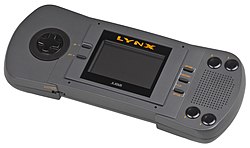
|

|
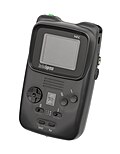
|
| Launch price | ¥12,500[14] US$89.95[15] |
US$189.99 | ¥14,500 US$149.99 A$155 |
US$299.99[16] |
| Release date | ||||
| Units sold | 118.69 million (as of December 31, 2009),[17] including Game Boy Color units[18] | 5 million (as of July 30, 2007)[11] | 15 million (as of July 30, 2007)[11] | 1.5 million[11] |
| Media | Cartridge | Cartridge | Cartridge | Datacard |
| Best-selling games | Tetris, 35 million (pack-in / separately).[19] Pokémon Red, Blue, and Green, approximately 20.08 million combined (in Japan and the US) (details).[20][21] |
Unknown | Sonic the Hedgehog 2 | Bonk's Adventure |
| Backward compatibility | No(Original Cartridges compatible with later models) | No | Sega Master System (using Cartridge Adapter) | No |
Popular games
History Of Video Game Consoles (fourth Generation) Media
The Philips CD-i, model number 220, a home interactive multimedia/game console first released in 1991. Multiple models were produced for either professional or consumer use. The 220 is one of the more common consumer models, and could be outfitted with an auxiliary video cartridge for enhanced video playback.
Notes
References
- ↑ 1.0 1.1 Santulli, Joe (2005). Digital Press Collectors Guide. USA: Digital Press. ISBN 978-0-9709807-0-0.
- ↑ "Bonk's Adventure Virtual Console Review - Wii Review at IGN". Wii.ign.com. Archived from the original on 2012-04-14. Retrieved 2012-08-15.
- ↑ Sonic the Hedgehog GameTap Retrospective Pt. 3/4. Event occurs at 1:21.
- ↑ Edge (2007-06-25). "The Nintendo Years". The Nintendo Years. Next-Gen.biz. p. 2. Archived from the original on 2012-09-05. Retrieved 2007-11-26.
- ↑ Gamate Archive Archived 2011-05-11 at the Wayback Machine, Video Game Gazette. Retrieved 2010-06-14.
- ↑ "Super NES". Classic Systems. Nintendo. Archived from the original on 2007-07-14. Retrieved 2007-12-04.
- ↑ Stephanie Strom (1998-03-14). "Sega Enterprises Pulls Its Saturn Video Console from the U.S. Market". The New York Times. https://www.nytimes.com/1998/03/14/business/international-business-sega-enterprises-pulls-its-saturn-video-console-us-market.html?pagewanted=1. Retrieved 2010-01-02.
- ↑ Ken Polsson. "Chronology of Sega Video Games 1952-1993". Archived from the original on 2006-12-17. Retrieved 2013-05-22.
Total North American sales in its lifetime: 14 million. Total world sales: 29 million.
- ↑ Théo Azevedo (2012-07-30). "Vinte anos depois, Master System e Mega Drive vendem 150 mil unidades por ano no Brasil" (in Portuguese). jogos.uol.com.br. Retrieved 2012-08-06.
{{cite web}}: CS1 maint: unrecognized language (link) - ↑ Alucard em Quarta-feira (2005-08-31). "A História do Mega Drive" (in Portuguese). gamehall.uol.com.br. Retrieved 2008-03-06.
{{cite web}}: CS1 maint: unrecognized language (link)[dead link] - ↑ 11.0 11.1 11.2 11.3 Blake Snow (2007-07-30). "The 10 Worst-Selling Handhelds of All Time". GamePro.com. Archived from the original on 2010-02-01. Retrieved 2010-01-02.
- ↑ Blake Snow (2007-07-30). "The 10 Worst-Selling Consoles of All Time". GamePro: 1. Archived from the original on 2007-05-08. https://web.archive.org/web/20070508014611/http://www.gamepro.com/gamepro/domestic/games/features/111822.shtml. Retrieved 2008-10-25.
- ↑ Blake Snow (2007-07-30). "The 10 Worst-Selling Consoles of All Time". GamePro: 2. Archived from the original on 2007-05-08. https://web.archive.org/web/20070508035815/http://www.gamepro.com/gamepro/domestic/games/features/111823.shtml. Retrieved 2008-10-25.
- ↑ "Game Boy History". Nintendo. Archived from the original on 2021-03-08. Retrieved 2009-03-27.
- ↑ Douglas C. McGill (5 June 1989). "Now, Video Game Players Can Take Show on the Road". The New York Times. https://www.nytimes.com/1989/06/05/business/now-video-game-players-can-take-show-on-the-road.html.
- ↑ Melanson, Donald (2006-03-03). "A Brief History of Handheld Video Games". Engadget. Retrieved 2009-01-27.
- ↑ "Consolidated Sales Transition by Region" (PDF). Nintendo. 2010-01-27. Archived (PDF) from the original on 2010-02-14. Retrieved 2010-02-14.
- ↑ "Game Boy". A Brief History of Game Console Warfare. BusinessWeek. Archived from the original on 2007-05-09. Retrieved 2008-07-30.
- ↑ "Did you know?". Nintendo. Archived from the original on 2007-11-09. Retrieved 2007-11-26.
- ↑ "Japan Platinum Game Chart". The Magic Box. Archived from the original on 2007-12-13. Retrieved 2007-11-26.
- ↑ "US Platinum Videogame Chart". The Magic Box. Archived from the original on 2007-01-06. Retrieved 2007-11-26.
- ↑ "100 Games Of All Time". gamers.com. Archived from the original on 2003-06-11. Retrieved 2006-09-03.
- ↑ "CAPCOM - Platinum Titles". Archived from the original on 2007-12-17. Retrieved 2013-05-22.
h




